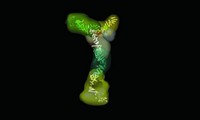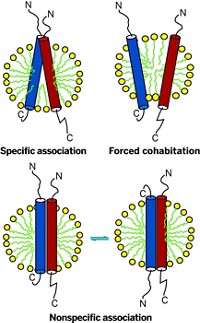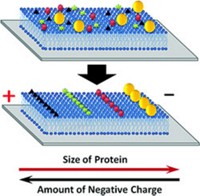Advertisement
Grab your lab coat. Let's get started
Welcome!
Welcome!
Create an account below to get 6 C&EN articles per month, receive newsletters and more - all free.
It seems this is your first time logging in online. Please enter the following information to continue.
As an ACS member you automatically get access to this site. All we need is few more details to create your reading experience.
Not you? Sign in with a different account.
Not you? Sign in with a different account.
ERROR 1
ERROR 1
ERROR 2
ERROR 2
ERROR 2
ERROR 2
ERROR 2
Password and Confirm password must match.
If you have an ACS member number, please enter it here so we can link this account to your membership. (optional)
ERROR 2
ACS values your privacy. By submitting your information, you are gaining access to C&EN and subscribing to our weekly newsletter. We use the information you provide to make your reading experience better, and we will never sell your data to third party members.
Analytical Chemistry
Lipids affect the function of membrane proteins
Researchers use multiple methods to show that lipids are more than just the backdrop for membrane proteins
by Celia Henry Arnaud
February 27, 2017
| A version of this story appeared in
Volume 95, Issue 9

Membrane proteins spend their time surrounded by lipids. For a long time, researchers thought those lipids didn’t really matter, that they were just a backdrop for the real players, an annoyance to be purified away before studying the proteins.
But that view is changing. “It doesn’t make any sense to disregard proteins’ direct environment,” says Cedric Govaerts, a biologist who studies membrane proteins at Université libre de Bruxelles. “It’s part of the picture. Why wouldn’t it play a role?” Not seeing lipids affecting membrane proteins, he says, would be the real surprise.
Suspecting lipid-protein effects and actually observing them are two different things. But thanks to improved biophysical and structural biology methods, more and more studies are finding that lipids do indeed play important roles in regulating the structure, function, and dynamics of membrane proteins. Many such proteins are potential drug targets, and understanding these interactions could give researchers another way to approach them.
Carol V. Robinson, a chemistry professor at the University of Oxford, once fell into the “lipids are a nuisance” camp. Her lab uses mass spectrometry to study the gas-phase structure of proteins. She initially thought the lipids her team saw in mass spectra of membrane proteins might be just artifacts of the purification process.
“But when we tried to get rid of them, we ran into a lot of problems,” she says. “The protein complex would often precipitate if the lipids weren’t there. Once we started looking at their effects on stability, we realized we could use the mass spec to inform us about the lipids that were important.”
Robinson’s analytical method of choice is a combination of ion mobility and mass spectrometry. The ion mobility separates protein complexes by size and shape, whereas the mass spectrometry separates them by mass-to-charge ratio. In a string of publications over the past several years, Robinson and coworkers have used the method to identify lipids that bind to membrane proteins with specificity.
Most recently, Robinson’s team reported the role of lipids in holding together membrane protein oligomers (Nature 2017, DOI: 10.1038/nature20820). They found that the amount of lipids binding at an oligomer’s interfaces is inversely correlated with the strength of the interactions between the protein monomers.
“If you’re very stable, you don’t need lipids to cement your interactions,” Robinson says. “If you’re much weaker, lipids come along and help glue membrane proteins together so that they can be functional.”
To detect the lipids in the mass spectrometer, Robinson’s team needed to adapt the method they had been using to study protein structures. In that previous method, they used detergent micelles to protect the proteins during the transfer from solution to the mass spectrometer. But the energy in the mass spectrometer’s collision cell that would usually be used for fragmenting the protein complex was instead going into removing the protein from the micelle. This meant they couldn’t get details about the complex, such as the lipids tagging along.
To get around that problem, the team increased the voltage they applied to the ionization region of the mass spectrometer. With this higher voltage, the protein gets released from the micelle before it enters the collision cell, and the activation energy in the collision cell can go to breaking up the protein complex. When the complex fragments, the researchers can see which subunits have lipids bound to them.
For example, the scientists found that the functional form of a bacterial amino acid transporter called LeuT has three phospholipids and one cardiolipin per subunit. A bacterial sugar transporter called SemiSWEET binds lipids when it forms its functional dimeric form. “These lipids are critical for mediating interactions in the membrane,” Robinson says.
In collaboration with David Drew of Stockholm University, Robinson’s team used mass spectrometry to study the role of lipids in three analogous proteins called antiporters. These proteins exchange sodium ions and protons to control pH as part of organisms’ response to sodium stress (Nat. Commun. 2017, DOI: 10.1038/ncomms13993). They have crystal structures for two of the proteins from different bacterial species. The combination of the crystal structures and the mass spectrometry data shows that one of the proteins needs lipids, including cardiolipin, for the subunits to stick together, whereas the other one doesn’t. Mass spec data of a human analog of the antiporter—for which a crystal structure has not yet been solved—suggest that it will be more like the one that doesn’t need lipids.
These antiporters have one domain that’s fixed and another that moves up and down like an elevator. Drew suspects that some lipids are “greasing” the motions. These seem to be different lipids from the ones that hold the oligomers together. He wants to further figure out which lipids are performing which functions and how they vary with conditions such as pH and charge.
Meanwhile, in Brussels, Govaerts and coworkers are studying how lipids affect the function of G protein-coupled receptors (GPCRs) and transporters in membrane mimics called lipid nanodiscs (Nat. Chem. Biol. 2015, DOI: 10.1038/nchembio.1960). For GPCRs, they find that the lipids act as allosteric modulators that affect how the receptors turn on and off. For example, they find that phosphatidylglycerol (PG) favors the active state of the β2-adrenergic receptor. Surprisingly, they saw this effect even when the lipids weren’t forming a bilayer, indicating that they behave in some ways like allosteric ligands.
The scientists don’t know how much these results will predict what’s happening in actual mammalian membranes, Govaerts says, because those membranes have little PG. But it’s possible that GPCRs and PG just have a strong affinity for each other. When the researchers pull the receptor out of a cell membrane, the lipids that tag along are greatly enriched in PG relative to its proportion in the overall membrane.
“It’s probably not going to be that all GPCRs are activated by the same lipids,” Govaerts says. “There probably is a reason the β2-adrenergic receptor really is preactivated by PG. We still don’t know that reason.”
For transporters, they find that lipids have an effect on the proteins only when the lipids form a bilayer. In the case of a bacterial multidrug transporter that binds protons to power the export of toxic compounds, interactions between lipid headgroups and the protein control the conformational transitions of the transporter required for binding and releasing substrates and protons (Nat. Struct. Mol. Biol. 2016, DOI: 10.1038/nsmb.3262).
In addition to simply identifying the lipids that are specifically interacting with membrane proteins, researchers want to determine thermodynamic parameters that quantify the strength of protein-lipid binding and provide insight into the binding mode.

Arthur Laganowsky, an assistant chemistry professor at Texas A&M University, uses native mass spectrometry to make such measurements. His team analyzed the binding of a bacterial ammonia channel with five kinds of lipids—cardiolipin and four lipids with identical tails but different head groups (J. Am. Chem. Soc. 2016, DOI: 10.1021/jacs.6b01771). All the lipids bound to proteins with similar equilibrium dissociation constants, but different thermodynamic factors drove the binding for different lipids.
Laganowsky is extending his work on the ammonia channel and investigating how lipids affect its interaction with the soluble, regulatory protein GlnK. Both the head group and the tail can independently influence the protein-protein interaction. For example, when he tested lipids with 12-, 14-, or 16-carbon tails, the 12- and 16-carbon chains enhanced binding, but the intermediate 14-carbon tail had no effect. “It’s as if it wasn’t there, but we know it’s bound in the mass spectrometer,” Laganowsky says. “Although the mechanism is unclear at the moment, these data suggest that the tails are probably binding to distinct pockets on the membrane protein.”
Laganowsky’s lab is working toward getting kinetic information on lipid binding, too. Measuring the rates of how lipids bind and fall off membrane proteins could help researchers understand how the environments around the proteins change over time. “We don’t know if a membrane protein in the bilayer enriches its own lipid environment,” he says. “Does it recruit its own lipid environment, or is it dynamic and moving? Kinetics is one way to get at that.”
One drawback of the mass spectrometry studies on lipids and proteins is that the measurements are made in the gas phase. Although the protein complexes seem to maintain their native structure, they aren’t in their native context, the cell membrane. Fluorescence spectroscopy, in contrast, allows researchers to observe lipid-protein interactions in intact membranes.
Adam W. Smith, an assistant chemistry professor at the University of Akron, uses a techniquderived from fluorescence correlation spectroscopy (FCS) called fluorescence cross-correlation spectroscopy to probe lipid-protein interactions. Christian Eggeling of the University of Oxford is also using FCS, but he’s combining it with a superresolution microscopy technique called STED. In FCS, a membrane protein and a lipid are labeled with dyes that fluoresce at different wavelengths. By tracking the motion of individual molecules, researchers can measure the rates of diffusion of the proteins and lipids to determine whether they are correlated.
“The untested hypothesis for these lipid-protein interactions is whether the lipid and protein are actually together long enough to matter for function,” Smith says. Some methods suggest they’re together for only a few hundred nanoseconds, and other methods suggest that at least some of the interactions are quite stable. But none of those methods measure the timescale directly. “We don’t know how long many of the membrane lipids associate with the membrane proteins,” he says. “It’s just totally a black box.”
In the FCS methods, researchers identify specific lipid-protein interactions by timing how long the labeled molecules take to move through a spot they’re observing on a membrane. Lipids that are interacting with proteins take much longer to cross the spot than those diffusing on their own. Because the spot is so much smaller in the superresolution STED technique than in conventional methods, the percent difference in transit times is much greater, which makes it easier to discern interactions.
The drawback of fluorescence methods is that both the protein and the lipid must be labeled. “Nobody wants to see this huge organic fluorophore stuck to a lipid, but I don’t see any way around it,” Smith says. The label affects the lipid’s ability to diffuse, but Smith thinks that probably doesn’t matter because they are focusing on the relative motions of lipids with and without proteins present, and the label is held constant across experiments. Eggeling highlights that many controls were used in the STED experiments to ensure that the observed interactions were indeed lipid specific and not artifacts of the labels’ effects on diffusion. The ultimate step, he says, is to develop forms of superresolution microscopy based on vibrational spectroscopy that will eliminate the need for labels.
Researchers aren’t restricted to experimental methods for studying lipid-protein interactions. Mark Sansom, a computational biochemist at the University of Oxford, is approaching the problem with molecular simulations. He and his coworkers have computationally modeled the lipid-protein interactions of proteins whose X-ray structures indicate the presence of lipids (Biochemistry 2016, DOI: 10.1021/acs.biochem.6b00751). “We can ask questions not only about where does the lipid bind on the protein but also about what’s the specificity in terms of what species of lipids are binding to the protein,” he says.
One challenge for simulations, Sansom says, is that lipids diffuse relatively slowly. For example, it takes several nanoseconds for two lipids to simply swap places in a membrane. In computational models, a nanosecond of real time takes on average 30 minutes of computing time. “If you want to properly mix your protein with all the different lipids and sample which lipids want to sit where on the protein, that requires quite long simulations,” Sansom says. Coarse-grain models in which groups of atoms are treated as particles simplify the system so the models can run faster but can still distinguish chemical differences in lipids.
Advertisement
“We know from biophysical studies that if a protein is diffusing in a membrane, it will pull tightly bound lipids with it,” Sansom says. “We suspect but don’t know for sure how the cell exploits that to regulate the activity of a protein.
“As people do more and more simulations of lipids in membranes, we are seeing more and more evidence of tight-binding lipids on protein surfaces,” Sansom continues. “It might not be universal to all membrane proteins, but many proteins have tightly bound specific lipids on their surface.”
But it still remains to be seen how much model systems, be they computational or experimental, can tell us about the real thing. Such systems have trouble recapitulating the asymmetry of lipid composition in real membranes.
“The inner and the outer leaflets don’t have the same composition. Most likely that will modulate the protein function, structure, dynamics, and kinetics,” Govaerts says. “Making an asymmetric bilayer in vitro is extremely complicated. Everything points to the fact that at some point we will have to make these measurements in a biological system.”





Join the conversation
Contact the reporter
Submit a Letter to the Editor for publication
Engage with us on Twitter